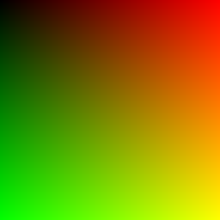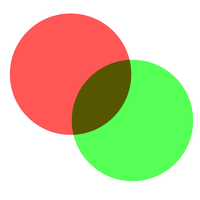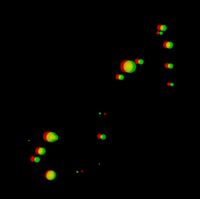An RG color model is a dichromatic color model represented by red and green primary colors. These can only reproduce a fraction of the colors possible with a trichromatic color space, such as for human color vision.
The name of the model comes from the initials of the two primary colors: red and green. The model may be either additive or subtractive.
It was used to display 3D images using anaglyphs since the 1850s. Despite its shortcomings in color reproduction, the RG model was used in early color processes for films from 1906 to 1929 (Kinemacolor, Prizma, Technicolor, Brewster Color, Kodachrome I and Raycol).
Additive RG
The additive RG color model uses red and green primaries. It was used in several processes during the early innovations of color photography, including Kinemacolor, Prizma, Technicolor I, and Raycol.

The primaries are added together in varying proportions to reproduce a linear gamut of colors, which can reproduce only a fraction of the colors possible with a trichromatic color space.
The appearance of the color gamut changes depending on the primary colors chosen. When the primaries are complementary colors (e.g. red and cyan), then an equal mixture of the primaries will yield a neutral color (gray or white). However, since red and green are not complementary colors, an equal mixture of these primaries will yield yellow, and a neutral color cannot be reproduced by the color space.
Until recently, its primary use was in low-cost LED displays in which red and green LEDs were more common and cheaper than the still nascent blue LED technology. However, this preference no longer applies to modern devices. In modern applications, the red and green primaries are equal to the primaries used in typical RGB color spaces. In this case, the RG color model can be achieved by disabling the blue light source.
 The additive RG color model showing the primary colors. Overlap area is an equal mixture thereof (yellow), not white.
The additive RG color model showing the primary colors. Overlap area is an equal mixture thereof (yellow), not white. Additive RG (modern example image).
Additive RG (modern example image). Additive RG Kinemacolor frame from Two Clowns (c.1907).
Additive RG Kinemacolor frame from Two Clowns (c.1907). Red and green LED traffic sign.
Red and green LED traffic sign.
Subtractive RG
The subtractive RG color model uses red and green filters for film exposure, but complementary cyan-green (for red) and orange-red (for green) for the developed prints. This allows the generation of white, although the color model cannot achieve black, regardless of the primaries chosen. It was used in several processes during the early innovations of color photography, including on Brewster Color I, Kodachrome I, Prizma II, and Technicolor II.
 The subtractive RG color model showing the primary colors. Overlap area is dark brown, not true black.
The subtractive RG color model showing the primary colors. Overlap area is dark brown, not true black. Subtractive RG (modern example image).
Subtractive RG (modern example image). Subtractive RG Technicolor II frame from The Toll of the Sea (1922)
Subtractive RG Technicolor II frame from The Toll of the Sea (1922)
Subtractive RGK

A similar color model, called RGK adds a black channel, which allows for the reproduction of black and other dark shades. However, it does not allow the reproduction of neutral colors (gray/white) because the primaries are not complementary.
Outside of a few low-cost high-volume applications, such as packaging and labelling, RG and RGK are no longer in use because devices providing larger gamuts such as CMYK are in widespread use.
Anaglyph 3D
Main article: Anaglyph 3DIn 1858, in France, Joseph D'Almeida delivered a report to l'Académie des sciences describing how to project three-dimensional magic lantern slide shows using red and green filters to an audience wearing red and green goggles. Subsequently he was chronicled as being responsible for the first realisation of 3D images using anaglyphs.
 Red-green anaglyph glasses
Red-green anaglyph glasses Red/Green anaglyph picture
Red/Green anaglyph picture Constellation of Scorpius in 3D anaglyph for red-green glasses. The perception of depth depends on how the image is scaled.
Constellation of Scorpius in 3D anaglyph for red-green glasses. The perception of depth depends on how the image is scaled. 3D image taken by ESA's Mars Express orbiter. The location is on the Martian equator north of Valles Marineris between 1° South to 2.5° North and 323° East. The area is 50 km across and shows mesas and cliffs as well as flow features indicating erosion by the action of flowing water. In this landscape view North is on the right. The 3D effect is only seen with the use of red/green 3D glasses.
3D image taken by ESA's Mars Express orbiter. The location is on the Martian equator north of Valles Marineris between 1° South to 2.5° North and 323° East. The area is 50 km across and shows mesas and cliffs as well as flow features indicating erosion by the action of flowing water. In this landscape view North is on the right. The 3D effect is only seen with the use of red/green 3D glasses.
See also
- List of monochrome and RGB color formats
- List of motion picture film formats
- List of color film systems
- rg chromaticity
- Anaglyphic color channels
References
- ^ D'Almeida, Joseph Charles (1858). "Nouvel appareil stéréoscopique" [A New Stereoscopic Device] (image). Gallica (Lecture) (in French). p. 61.
- Corporation, Bonnier (February 13, 1923). "Popular Science". Bonnier Corporation – via Google Books.
- Thomas, Elway (1923). "First Successful Color Movie". Popular Science (Feb 1923): 59.
- "Kinemacolor".
- Trenholm, Richard. "The first Technicolor film was a total disaster a century ago". CNET.
- Cinematographic Multiplex Projection, &c. U.S. Patent No. 1,391,029, filed February 20, 1917.
- "Moving Pictures in Color", The New York Times, February 22, 1917, p. 9.
- "The first Technicolor film was a total disaster a century ago". CNET. September 9, 2017. Retrieved June 27, 2018.
- "Raycol".
- Cherchi Usai, Paolo (2000). Silent Cinema. British Film Institute. p. 35.
- Nowotny, Robert Allen (January 1, 1983). The Way of All Flesh Tones: A History of Color Motion Picture Processes, 1895-1929. pp. 127–129. ISBN 9780824051099. Retrieved May 29, 2015.
- "Patent 1,145,968 - Photographic Film" (PDF). United States Patent Office. July 13, 1915. Retrieved May 29, 2015.
- "Brewster".
- Capstaff, a former portrait photographer and physics and engineering student had already worked on colour photography before he joined C.K. Mees and other former Wratten and Wainright employees in their move to Rochester in 1912–1913 after Eastman had bought that company to persuade Mees to come and work for him.
- "Complete National Film Registry Listing". Library of Congress. Retrieved January 2, 2017.
- "2012 National Film Registry Picks in A League of Their Own". Library of Congress. Retrieved 2020-05-13.
- "Prizma II".
- Trenholm, Richard. "The first Technicolor film was a total disaster a century ago". CNET. Retrieved October 14, 2019.
- "The First Successful Color Movie", Popular Science, Feb. 1923, p. 59.
- "Kalmus, Herbert. "Technicolor Adventures in Cinemaland", Journal of the Society of Motion Picture Engineers, December 1938"
- "Application filed by Germann & Gsell Ag".
- Picard, Emile (December 14, 1931). "La Vie et L'œuvre de Gabriel Lippmann (membre de la section de physique générale)" [The Life and Work of Gabriel Lippmann] (PDF). academie-sciences.fr (Public Lecture) (in French). Institut de France. Académie des Sciences. p. 3.
External links
- Even Proportional Color Triangle
- Cinematographic Multiplex Projection, &c. U.S. Patent No. 1,391,029, filed Feb. 20, 1917.
- "Moving Pictures in Color", The New York Times, February 22, 1917, p. 9.
- The First Successful Color Movie", Popular Science, Feb. 1923, p. 59.
- filmmakeriq.com, The History and Science of Color Film: From Isaac Newton to the Coen Brothers
| Color space | |
|---|---|
| CAM | |
| CIE | |
| RGB | |
| Y′UV | |
| Other | |
| Color systems and standards | |
| For the vision capacities of organisms or machines, see | |